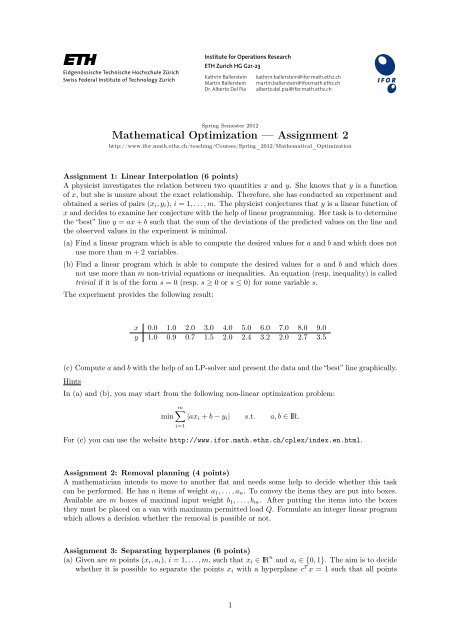Mathematical Optimization â Assignment 2 - IFOR
Mathematical Optimization â Assignment 2 - IFOR
Mathematical Optimization â Assignment 2 - IFOR
You also want an ePaper? Increase the reach of your titles
YUMPU automatically turns print PDFs into web optimized ePapers that Google loves.
Institute for Operations Research<br />
ETH Zurich HG G21-23<br />
Kathrin Ballerstein kathrin.ballerstein@ifor.math.ethz.ch<br />
Martin Ballerstein martin.ballerstein@ifor.math.ethz.ch<br />
Dr. Alberto Del Pia alberto.del.pia@ifor.math.ethz.ch<br />
Spring Semester 2012<br />
<strong>Mathematical</strong> <strong>Optimization</strong> — <strong>Assignment</strong> 2<br />
http://www.ifor.math.ethz.ch/teaching/Courses/Spring_2012/<strong>Mathematical</strong>_<strong>Optimization</strong><br />
<strong>Assignment</strong> 1: Linear Interpolation (6 points)<br />
A physicist investigates the relation between two quantities x and y. She knows that y is a function<br />
of x, but she is unsure about the exact relationship. Therefore, she has conducted an experiment and<br />
obtained a series of pairs (x i ,y i ), i = 1,...,m. The physicist conjectures that y is a linear function of<br />
x and decides to examine her conjecture with the help of linear programming. Her task is to determine<br />
the “best” line y = ax+b such that the sum of the deviations of the predicted values on the line and<br />
the observed values in the experiment is minimal.<br />
(a) Find a linear program which is able to compute the desired values for a and b and which does not<br />
use more than m+2 variables.<br />
(b) Find a linear program which is able to compute the desired values for a and b and which does<br />
not use more than m non-trivial equations or inequalities. An equation (resp. inequality) is called<br />
trivial if it is of the form s = 0 (resp. s ≥ 0 or s ≤ 0) for some variable s.<br />
The experiment provides the following result:<br />
x 0.0 1.0 2.0 3.0 4.0 5.0 6.0 7.0 8.0 9.0<br />
y 1.0 0.9 0.7 1.5 2.0 2.4 3.2 2.0 2.7 3.5<br />
(c) Compute a and b with the help of an LP-solver and present the data and the “best” line graphically.<br />
Hints<br />
In (a) and (b), you may start from the following non-linear optimization problem:<br />
m∑<br />
min |ax i +b−y i | s.t. a,b ∈ IR.<br />
i=1<br />
For (c) you can use the website http://www.ifor.math.ethz.ch/cplex/index.en.html.<br />
<strong>Assignment</strong> 2: Removal planning (4 points)<br />
A mathematician intends to move to another flat and needs some help to decide whether this task<br />
can be performed. He has n items of weight a 1 ,...,a n . To convey the items they are put into boxes.<br />
Available are m boxes of maximal input weight b 1 ,...,b m . After putting the items into the boxes<br />
they must be placed on a van with maximum permitted load Q. Formulate an integer linear program<br />
which allows a decision whether the removal is possible or not.<br />
<strong>Assignment</strong> 3: Separating hyperplanes (6 points)<br />
(a) Given are m points (x i ,a i ), i = 1,...,m, such that x i ∈ IR n and a i ∈ {0,1}. The aim is to decide<br />
whether it is possible to separate the points x i with a hyperplane c T x = 1 such that all points<br />
1
with a i = 0 satisfy c T x i ≤ 1 and all points with a i = 1 satisfy c T x i > 1. Formulate the decision<br />
problem as a linear optimization problem.<br />
(b) Given are m points (x i ,y i ), i = 1,...,m, such that x i ∈ IR n and y i ∈ IR. The aim is to find<br />
vectors b 1 , b 2 , and c such that the hyperplane c T x = 1 partitions the m points into two parts and<br />
the following expression is minimized:<br />
∑ ∑<br />
|y i −b T 1x i |+ |y i −b T 2x i |.<br />
{i:c T x i≤1}<br />
{i:c T x i>1}<br />
Formulate a mixed-integer linear optimization problem to determine the vectors b 1 , b 2 , and c.<br />
(Due date: Friday, March 9th, 2012, before the exercise class)<br />
2
















